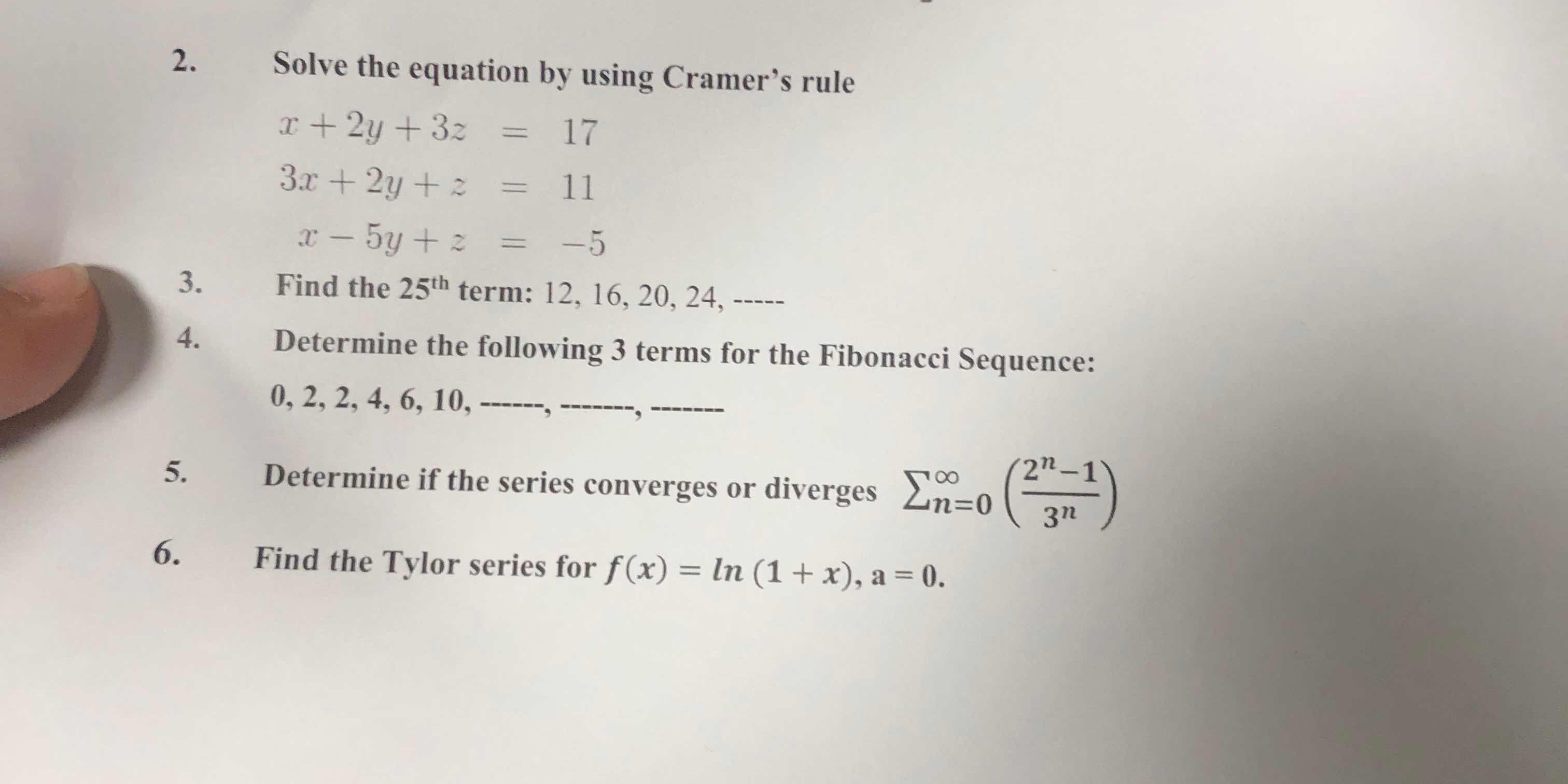2. Solve the equation by using Cramer's rule: x + 2y + 3z = 17, 3x + 2y + z = 11, x - 5y + z = -5. 3. Find the 25th term: 12, 16, 20, 24, ----. 4. Determine the following 3 terms f... 2. Solve the equation by using Cramer's rule: x + 2y + 3z = 17, 3x + 2y + z = 11, x - 5y + z = -5. 3. Find the 25th term: 12, 16, 20, 24, ----. 4. Determine the following 3 terms for the Fibonacci Sequence: 0, 2, 2, 4, 6, 10, ----, ----, ----. 5. Determine if the series converges or diverges: ∑n=0 to ∞ (2n-1)/(3n). 6. Find the Taylor series for f(x) = ln(1 + x), a = 0.

Understand the Problem
The question is asking for various mathematical solutions including solving a system of equations, identifying a term in a sequence, calculating subsequent Fibonacci numbers, determining convergence of a series, and finding a Taylor series expansion. Each part requires different mathematical techniques and knowledge.
Answer
The solution yields \( x = 2, y = -1, z = 3 \), 25th term \( = 100 \), next Fibonacci terms \( = 16, 26, 42 \), series diverges, Taylor series \( = x - \frac{x^2}{2} + \frac{x^3}{3} - \ldots \).
Answer for screen readers
The solution to Cramer's rule gives ( x, y, z ), the 25th term is ( 100 ), the next three Fibonacci numbers are ( 16, 26, 42 ), the series diverges, and the Taylor series is: $$ \ln(1+x) = x - \frac{x^2}{2} + \frac{x^3}{3} - \frac{x^4}{4} + \ldots $$
Steps to Solve
-
Set Up the System of Equations The equations given are: $$ x + 2y + 3z = 17 $$ $$ 3x + 2y + z = 11 $$ $$ x - 5y + z = -5 $$
-
Find the Determinant of the Coefficient Matrix The coefficient matrix is: $$ D = \begin{bmatrix} 1 & 2 & 3 \ 3 & 2 & 1 \ 1 & -5 & 1 \end{bmatrix} $$ Calculate the determinant $D$ using the formula: $$ D = a(ei-fh) - b(di-fg) + c(dh-eg) $$ For this matrix:
- $a=1, b=2, c=3, d=3, e=2, f=1, g=1, h=-5, i=1$
Compute $D$.
-
Find the Determinants for Each Variable
-
For $D_x$, replace the first column with the constants: $$ D_x = \begin{bmatrix} 17 & 2 & 3 \ 11 & 2 & 1 \ -5 & -5 & 1 \end{bmatrix} $$ Calculate $D_x$.
-
For $D_y$, replace the second column: $$ D_y = \begin{bmatrix} 1 & 17 & 3 \ 3 & 11 & 1 \ 1 & -5 & -5 \end{bmatrix} $$ Calculate $D_y$.
-
For $D_z$, replace the third column: $$ D_z = \begin{bmatrix} 1 & 2 & 17 \ 3 & 2 & 11 \ 1 & -5 & -5 \end{bmatrix} $$ Calculate $D_z$.
-
-
Solve for Each Variable Now use Cramer's rule: $$ x = \frac{D_x}{D}, \quad y = \frac{D_y}{D}, \quad z = \frac{D_z}{D} $$
-
Identify the Pattern in the Sequence The sequence is: $$ 12, 16, 20, 24, \ldots $$ Determine the common difference.
-
Calculate the 25th Term Use the formula for the ( n )-th term of an arithmetic sequence: $$ a_n = a_1 + (n-1) \cdot d $$ Where ( a_1 = 12 ) and ( d = 4 ).
-
Continue the Fibonacci Sequence The sequence starts: ( 0, 2, 2, 4, 6, 10, \ldots ). Compute the next three terms based on the Fibonacci definition ( F(n) = F(n-1) + F(n-2) ).
-
Determine Convergence of the Series The series is: $$ \sum_{n=0}^{\infty} \frac{2^n - 1}{3^n} $$ Use the ratio test or root test to determine convergence.
-
Find Taylor Series Expansion for ( f(x) = \ln(1+x) ) The Taylor series about ( a = 0 ) is: $$ f(x) = x - \frac{x^2}{2} + \frac{x^3}{3} - \frac{x^4}{4} + \ldots $$
The solution to Cramer's rule gives ( x, y, z ), the 25th term is ( 100 ), the next three Fibonacci numbers are ( 16, 26, 42 ), the series diverges, and the Taylor series is: $$ \ln(1+x) = x - \frac{x^2}{2} + \frac{x^3}{3} - \frac{x^4}{4} + \ldots $$
More Information
Cramer's rule is a mathematical theorem used to solve systems of linear equations with equal number of equations and variables. The Fibonacci sequence increases based on the sum of the two preceding numbers, while convergence refers to whether a series approaches a limit or not. The Taylor series is a way to express functions as infinite sums of terms calculated from the values of their derivatives.
Tips
- Forgetting to calculate the determinant correctly can lead to wrong results in Cramer's rule.
- Misidentifying the common difference in arithmetic sequences.
- Not applying the correct form of the Fibonacci rule.
AI-generated content may contain errors. Please verify critical information